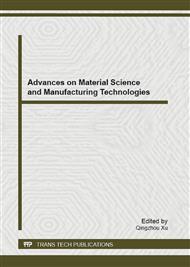p.3
p.8
p.11
p.17
p.23
p.27
p.31
p.35
Synthesis and Characterization of Acrylamide Based Benzoxazine
Abstract:
Novel benzoxazine monomers, acrylamide based benzoxazine, have been prepared from direct condensation of phenols with acrylamide and formaldehyde. 1H NMR and FT-IR, DSC and TGA were used to analysis the structure, compositions and investigate the curing behaviour and thermal stability, respectively. Solvent effects were studied. Solventless method is good for higher formation ratio of benzoxazine to the corresponding phenolic resin. The ratio for P-AA is 36.4% by solventless method, while it’s about 26% by toluene solvent; and 44% and 20% for B-AA, respectively. The monomers mixtures exhibit curing temperature (ca.187oC) without catalysts lower than their related allyl-benzoxazine. The FT-IR of different curing temperature shows the disappearance of double bond absorption at 1668 cm-1 and oxazine ring at 1232 cm-1 and appearance of hydroxyl group at 3446 cm-1. Thermal stability of cured benzoxazine show good char residues compared with traditional benzoxazine of aniline.
Info:
Periodical:
Pages:
11-16
Citation:
Online since:
December 2012
Authors:
Price:
Сopyright:
© 2013 Trans Tech Publications Ltd. All Rights Reserved
Share:
Citation:


